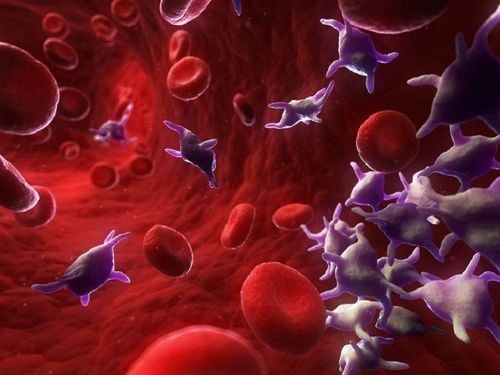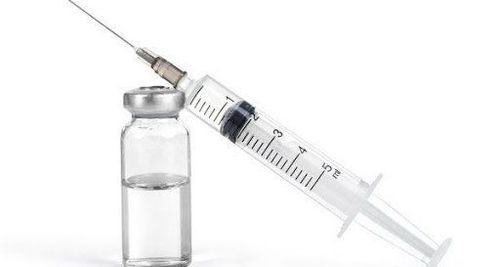This is an automatically translated article.
Corifact is a prescription medication, used to prevent bleeding in people with bleeding disorders caused by factor XIII deficiency. To ensure the effectiveness of using Corifact, patients need to follow the instructions of a specialist.
1. What are the uses of Corifact?
1.1. What is Corifact? Corifact belongs to the group of anticoagulant drugs, is an exclusive registered trademark of CSL Behring GmbH Pharmaceutical company - USA.
1 Corifact box contains:
Active ingredient: Factor XIII concentrate 1000-1600 units. Sterile water for injection 1 tube 20ml. The Corifact Mix2 Vial filter adapter is recommended for adult use.
1.2. What does Corifact do?
Corifact is prescribed for use as a prophylactic and therapeutic drug to prevent bleeding episodes in people with an inherited bleeding disorder caused by factor XIII deficiency. Factor XIII is a naturally occurring protein in the blood that helps blood to clot. Patients with factor XIII deficiency are still able to form clots, but the clot's texture is unstable and begins to rupture 24 to 48 hours after formation. Without factor XIII, the fibrin fibers are only loosely organized and cannot crosslink, so clots are easier to dissolve. The rapid breakdown of the clot leading to bleeding episodes is typical of factor XIII deficiency. Corifact works by temporarily raising the levels of these factor XIII in the blood to aid in blood clotting.
Contraindications to taking Corifact:
Patients are allergic to the main active ingredient Factor XIII or any of the excipients of the drug. Persons with known severe anaphylactic or systemic reactions to products derived from human plasma.
2. How to use the drug Corifact
2.1. How to use the drug Corifact Corifact is administered intravenously . Do not mix Corifact with other injectable drugs in the same intravenous line. Each bottle of Corifact is for 1 use only. Use Corifact exactly as directed by your doctor, do not inject more or less the prescribed dose. 2.2. How to prepare Corifact Make sure that the Corifact vial and pre-diluent vial are at room temperature. Place the Corifact vial, diluent vial, and Mix2 Vial adapter on a flat surface. Remove the Corifact vial and flip the diluent vial upside down. Wipe the stopper with alcohol-soaked cotton and let it dry naturally before unpacking the Mix2 Vial adapter. Open the package of the Mix2Vial adapter. Keep the Mix2 Vial adapter in its original packaging. Place the diluent vial on a flat surface and hold the vial firmly. Grip the Mix2 Vial adapter by the sheath and firmly press the plastic spike on the blue end of the Mix2 Vial adapter through the center of the stopper of the diluent vial. Carefully remove the packaging from the Mix2 Vial adapter. Carefully remove the outer cover, do not pull up the Mix2 Vial adapter. With the Corifact vial firmly placed on a flat surface, invert the vial of diluent attached to the Mix2 Vial adapter and firmly press the transparent adapter plastic stopper through the center of the Corifact vial stopper. The diluent will automatically transfer to the Corifact vial. With the diluent vial and the Corifact vial still attached to the Mix2 Vial adapter, rotate the Corifact vial gently to ensure that the drug in the Corifact vial is completely dissolved. Absolutely DO NOT shake the vial. Grasp the Mix2 Vial adapter's Corifact vial with one hand and the other hand to the Mix2 Vial adapter's blue diluent vial, dismantling the two-piece adapter Draw some air into an empty sterile syringe. Holding the Corifact vial vertically, screw the syringe into the Mix2 Vial adapter. Pump some air into the Corifact vial. While still holding the plunger of the syringe, draw the concentrate into the syringe by pulling the plunger slowly back. The entire concentrate was transferred into the syringe, hold the plunger firmly, and remove the syringe from the Mix2 Vial adapter. Then attach the syringe to the appropriate intravenous set. If the patient needs to use more than one vial, combine the concentrates in multiple vials into one syringe. Each vial uses a separate unused Mix2 Vial adapter. Corifact can only be used once. The drug does not contain preservatives. The product must be used within 4 hours of mixing. Do not refrigerate or freeze the reconstituted solution. Dispose by garbage classification of used or partially used vials. 2.3. Dose of Corifact 40(IU)/kg body weight at a rate not exceeding 4 ml/min. Adjust the dose ± 5 IU per kg to maintain FXIII activity levels between 5% and 20% according to the following table:
| Mức độ hoạt động FXIII (%) | Thay đổi liều lượng |
| Một mức <5% | Tăng 5 IU mỗi kg |
| Trong khoảng 5 – 20% | Không thay đổi |
| Hai mức >20% | Giảm 5 IU mỗi kg |
| Một mức >25% | Giảm 5 IU mỗi kg |
Usual prophylactic dose, given every 28 days.
Management of intraoperative bleeding:
Dosage must be individualized based on the patient's FXIII activity level, type of surgery, and clinical response. Monitor patient's FXIII activity level during and after surgery. Guidelines for dose adjustment for preoperative management.
| Thời gian kể từ liều cuối cùng | Liều lượng |
| Trong vòng 7 ngày | Liều bổ sung có thể không cần thiết |
| 8-21 ngày | Có thể cần bổ sung một phần hoặc toàn bộ liều dựa trên mức độ hoạt động của FXIII |
| 21-28 ngày | Liều dự phòng đầy đủ |
Handling when missed dose: Corifact is administered by medical staff at medical facilities, so it is possible to limit the missed dose.
Treatment of overdose: No statistics yet
3. Notes when using Corifact
Corifact is usually taken about once a month, depending on the patient's recent blood test results. Reconstituted Corifact should be clear or slightly yellow in color. Do not use the medicine if it has changed color or there is a precipitate in the vial. Corifact is made from human plasma, which may contain viruses and other infectious agents. Donated plasma has been tested and processed to reduce the risk of containing an infectious agent, but there is still a very small chance that it may still contain pathogens and possibly be an intermediary. Corifact can increase a person's risk of blood clotting problems. Tell your doctor right away if you have a sudden or severe headache, problems with your voice or vision, trouble breathing, chest pain, or numbness in your limbs while you are taking this medicine. If signs or symptoms of anaphylaxis or hypersensitivity reaction (including rash, urticaria, chest tightness, wheezing, hypotension) occur, discontinue use immediately. Inhibitors against FXIII have been detected in patients receiving Corifact. Patients should be monitored to control the development of inhibitory antibodies. The presence of inhibitory antibodies may manifest as an inadequate response to treatment. If the expected level of FXIII plasma activity is not achieved or if sudden bleeding occurs during prophylactic therapy, perform an FXIII inhibitory antibody test. Thromboembolic complications have been reported with the use of Corifact. Monitor patients with known risk factors for thrombotic events. Not intended for use by pregnant and lactating women.
4. Side effects of the drug Corifact
At therapeutic doses, Corifact is well tolerated. However, the process of using Corifact, patients may still experience side effects such as:
Common:
Arthritis, hypersensitivity, rash, itching, erythema, hematoma, joint pain, headache, increased levels of thrombin-antithrombin and increased lactate dehydrogenase in the blood. Nosebleeds, bruises, dark bruises, fever, itching, pain, redness, or swelling. Incidence unknown:
Chest tightness, cough, dizziness or fainting; Pain in the chest, groin or legs, especially the calves; puffiness or swelling of the eyelids or around the eyes, face, lips, or tongue; Red, swollen, scaly, or flaky skin; sudden, severe headache; Shortness of breath; Pain, warmth to the touch, swelling, discolored skin and prominent superficial veins above the affected area; Unusual weakness or fatigue. If you experience these symptoms, the patient should stop using Corifact and notify the doctor for appropriate treatment.
5. Corifact drug interactions
Using Corifact with Coagulation Factor VIIa is generally not recommended, but may be required in some special cases. If both medicines are prescribed together, your doctor may need to change the dose or frequency of using one or both of them.
6. How to store Corifact
Corifact keeps well for 36 months, up to the expiration date on the can and vial labels Store unmixed Corifact in the refrigerator at 2-8°C (36-46°F), but do not freeze. Keep the medicine in the original packaging. Unopened vials can also be stored at room temperature for up to 6 months, protected from moisture, heat and light. Do not refrigerate unopened vials that have been stored at room temperature. After mixing with the diluent, store at room temperature and use within 4 hours. Do not refrigerate or freeze. Do not put the product in the refrigerator after it has been stored at room temperature. Clearly mark the start date of storage at room temperature on the carton label. Do not use Corifact beyond the expiration date indicated on the box and vial labels. Above is all information about the drug Corifact, patients need to carefully read the instructions for use, consult a doctor / pharmacist before using. Note, Corifact is a prescription drug, patients need to use the drug as prescribed by the doctor, absolutely do not self-treat at home.













